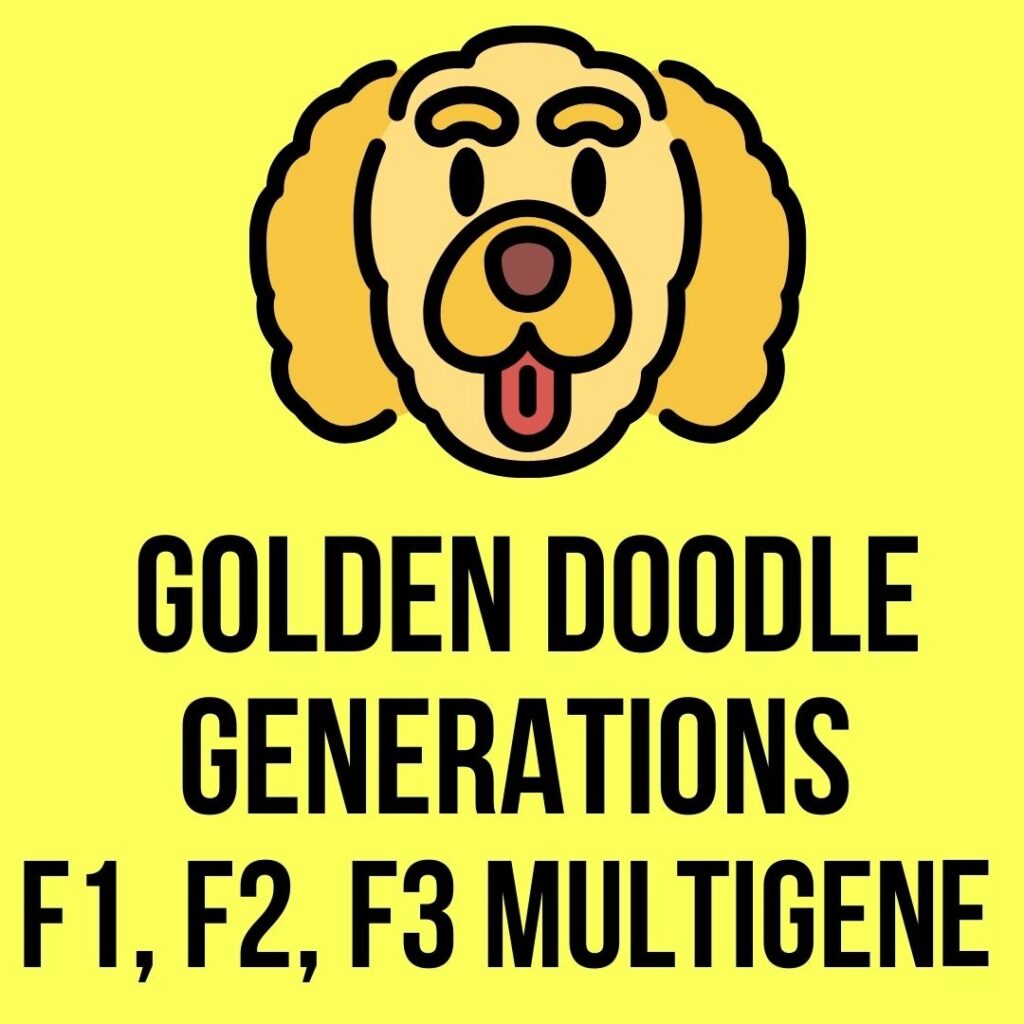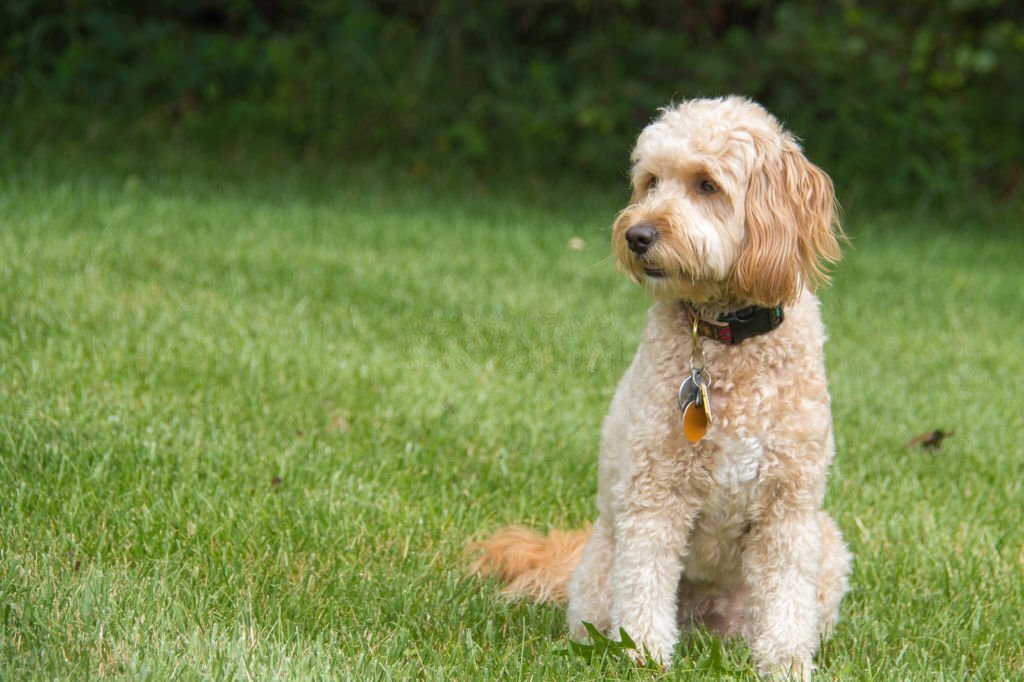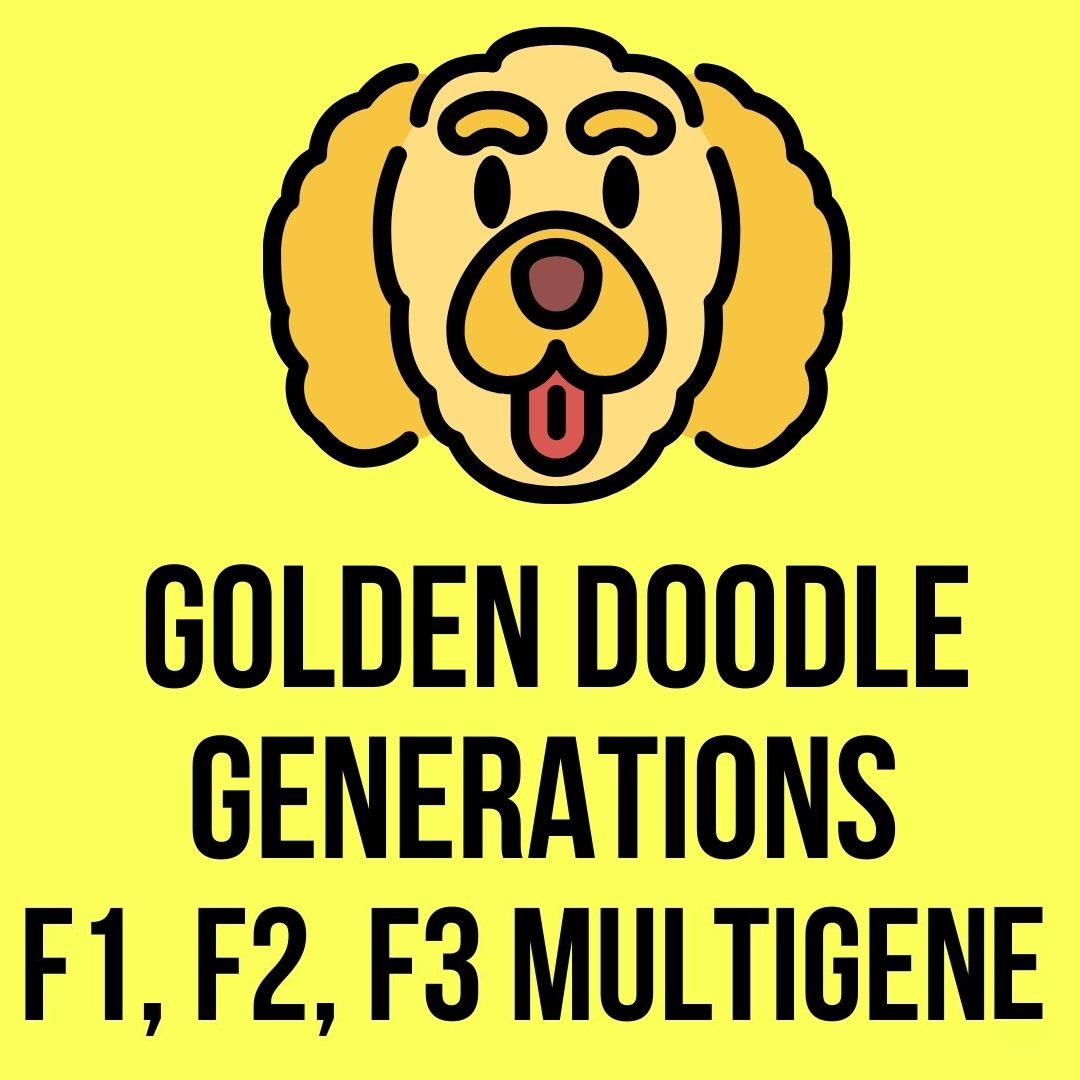Are the Doodle Generations confusing you? Types of Doodles, Wondering which Doodle Generation Dog you should bring home? Which Dood Dog is healthy, safe, and loving among all? What generation of doodles is the best?
In regards to Goldendoodle Generations, pet lovers have multiple questions in mind. Thus, today, through this guide, we are trying to bring some clarity to the topic. For more information, continue reading.
Contents
- Goldendoodle Generations and What do they Mean?
- What does the “F” mean In Multigene Goldendoodles?
- F1, F1B, F1BB, F2, F2B, F2BB, F3, Multigene Comparison Table
- F1 Goldendoodle (Personality, Size, temperament, lifespan)
- F2 Goldendoodle (Personality, Size, temperament, lifespan)
- F3 Goldendoodle (Personality, Size, temperament, lifespan)
- What is an F1BB Goldendoodle?
- What is a Multigene Goldendoodle?
- F1 vs F2 Goldendoodles Comparison
- What generation of Goldendoodle is best?
- Which is better, F1 or F1B Goldendoodle?
- What generation of Goldendoodle is healthiest?
- What is the calmest Doodle breed?
- Are girl or boy Goldendoodles better?
- Can you breed 2 F1B Goldendoodles?
- Conclusion
Goldendoodle Generations (F1, F1B, F1BB, F2, F2B, F2BB, F3, Multigene)
Goldendoodle, or as they often say, Groodle is one of the most popular pet dog breeds. It is a crossbreed that came down from mix-breeding between Golden Retriever and Poodle.
Goldendoodles are loyal, playful, and easy to train. They are also one of the best pet choices for individuals with pet allergies since Groodles are hypoallergenic.
They make fantastic cuddle buddies and are one of the most affectionate and friendly breeds of dogs. However, while you step out to adopt a Goldendoodle, there are a lot of terms that might confuse you.
Generally, adopting a dog is a confusing process since there are many options available around. Though with Groodles, the varieties in the breed itself and the terminologies such as F1, F1B, F1BB, and Multigen take individuals into a state of confusion.
Especially these weird cryptic letters make the choosing process tricky, confusing, and full of hassle. However, since we are here, things like these must not bother you.
Join us and explore all about Goldendoodles, including their size, color, and specifically ‘Generations’. Let’s get started.

Goldendoodle Generations and What do they Mean?
What is a doodle generation? The idea of Goldendoodle Generations is surrounded by sheer confusion for many. Even most of the already Groodle owners aren’t even familiar with which generation dog they have. For most of them, every Goldendoodle is the same. However, in reality, they aren’t.
Goldendoodles are designer dogs that came down from Golden Retrievers and Poodles. The first-generation Groodles are 50% poodle and 50% retriever and have traits from both their parent breeds.
The percentage can vary significantly; however, not with high numbers. Later, when the terminology like F1 comes into the chart, it brings confusion.
Though in reality, F1 means 50% Golden Retriever and 50% Poodle, whereas F2 means the result of two existing 50/50 hybrids.
For more clarity, we will discuss every generation in detail further in the article.
What does the “F” mean In Multigene Goldendoodles?
Every Goldendoodle generation begins with the letter ‘F’. Here ‘F’ means Filial Hybrid, which explains that Goldendoodle is a hybrid dog that came down from two different purebreds. For Goldendoodles, the pure parent breed is Golden Retriever and Poodle.
Following the letter, ‘F’ are different numbers of a set of Numbers and Alphabets. These are indicators of what generation the Goldendoodle is. For example, F1 means the first generation, F2 means the second generation, and F3 means the third generation.
Further, some Goldendoodle breeds have the letter ‘B’ in them. B here means backcross, which defines breeding the current Goldendoodle generation to a purebred Poodle.
And while the terminology has two BBs (F1BB and F2BB), it indicates that the generation of Goldendoodle was backcrossed twice with a Poodle. However, Goldendoodles with ‘B’ and ‘BB’ are extremely uncommon.
F1, F1B, F1BB, F2, F2B, F2BB, F3, Multigene Comparison Table
Before deciding on which Goldendoodle you want, understanding the terminology is very crucial. Here is a Goldendoodle generation comparison chart for easy reference.
Ahead of understanding the generations in detail, this comparison table will provide you with a quick and easy idea of what’s coming. Have a look:
| Generations | First Parent | Second Parent | Golden Retriever DNA Percentage (Estimation) | Poodle DNA Percentage (Estimation) |
| F1 Goldendoodle | Purebred Poodle | Purebred Golden Retriever | 50% | 50% |
| F1B Goldendoodle | F1 Goldendoodle | Purebred Poodle | 25% | 75% |
| F1BB Goldendoodle | F1B Goldendoodle | Purebred Poodle | 12.5% | 87.5% |
| F2 Goldendoodle | F1 Goldendoodle | F1 Goldendoodle | 50% | 50% |
| F2B Goldendoodle | F2 Goldendoodle | Purebred Poodle | 37.5% | 62.5% |
| F2BB Goldendoodle | F2B Goldendoodle | Purebred Poodle | 18.75% | 18.75 |
| F3 Goldendoodle | F2 Goldendoodle | F2 Goldendoodle | 50% | 50% |
| Multigene Goldendoodle | The mix breeding here varies | The mix breeding here varies | Varies | Varies |
Note: The DNA percentage mentioned above is a mere estimation and is for reference purposes only.
Even a breeder can never calculate the exact DNA percentage of an individual mix breed puppy/ dog.

F1 Goldendoodle (Personality, Size, temperament, lifespan)
F1 Goldendoodle is the first generation mix breed between a purebred 100% Golden Retriever and a purebred 100% Standard Poodle. It is the classic Goldendoodle with roughly 50% DNA from both parent breeds.
However, how they look and what personality will they take depends totally upon the dominant DNA percentage of their parent breed. And if the percentages are equal, the F1 Goldendoodle will be a true half copy of both Golden Retriever and Poodle.
F1 Goldendoodle is also considered a Hybrid Vigor that states the first cross will be healthier than a purebred dog.
Depending upon the dominance of genetics, their appearance may differ to a great extent.
F1 Goldendoodles will shed less than a Golden Retriever; however, their shedding can still be termed as moderate. Also, they will trigger allergies, unlike what Goldendoodles are known for (hypoallergenic).
F1 Goldendoodles are genetically diverse and thus will less likely inherit any health issues from the purebred.
- Personality: Higher poodle gene participation. They are smart and intelligent a little nervous and high-strung like poodles.
- Size: Typically, between 50 to 75 lbs as young/ adults.
- Temperament: Gentle, Calm, laid back, and highly social.
- Lifespan: 10 to 15 years of healthy life.

F2 Goldendoodle (Personality, Size, temperament, lifespan)
Little do pet enthusiasts know, but F2 Goldendoodles can come down with lots of parent combinations.
For example, this generation can be a result of mixed breeding between,
- An F1 with an F1
- F1 with an F1B
- An F1 with an F2
F1 and F1 are the most common pairing that produces the F2 Goldendoodle generation.
F2 Goldendoodles, though, are similar to F1, but they most likely have higher traits of a Golden Retriever.
However, since F2 is the most unpredictable generation in terms of DNA, breeders often refrain from efforting for this particular type.
F2 Goldendoodles are ideal for individuals who suffer from dog allergies. This generation has a significant amount of Retriever traits and isn’t likely the allergy sufferers.
Instead of poodles, their appearance and habits are closer to Golden Retrievers. Whereas in terms of cost, F2 Goldendoodles are more expensive due to their DNA unpredictability.
- Personality: They sometimes present an attitude like a Golden retriever. They are good protectors and rarely aggressive.
- Size: Typically, between 35 to 55 lbs as young/ adults
- Temperament: Gentle, Calm, laid back, intelligent.
- Lifespan: 10 to 15 years
F3 Goldendoodle (Personality, Size, temperament, lifespan)
F3 Goldendoodles are the greater of Goldendoodle, ideally the third generation. They are produced with an F1-B generation and a variety of others, or two pure F2 generations.
F3 Goldendoodles are very rare and less likely to be seen since they are unpredictable and challenging to breed. What makes breeders skeptical about them is the fact that F3s aren’t consistent or predictable.
It is almost impossible to predict or determine what type of coat will an F3 Goldendoodle will have. They inherit the Golden Retriever’s traits for most of the part, but until the puppy is born, nothing can be estimated.
F3 Goldendoodles as puppies are prone to shedding. However, once they grow old, their shedding rate decreases as well. Instead of soft and wavy, their coat is flatter ad sporty. F3 Goldendoodles are also are also hypoallergenic.
- Personality: They like to sit back and watch people and may develop health issues like Golden Retriever due to DNA dominance.
- Size: Typically, between 35 to 50 lbs.
- Temperament: Easy going with a laid-back behavior (not at all sharp)
- Lifespan: 10 to 12 years on an average
What is an F1B Goldendoodle?
F1B Goldendoodle is a breed from 25% Golden Retriever and 75% Poodle. They are usually non-shedding or very light-shedding dogs. F1Bs are also known as backcross.
F1B Goldendoodle inherits some of the health benefits of being Hybrid Vigor. They are less allergic and thus best for individuals who aren’t particularly concerned about dog allergies.
What is an F1BB Goldendoodle?
F1BB Goldendoodle is a crossbreed backcrossed twice with a Poodle.
They have high Poodle DNA and are highly suitable for allergy sufferers.
They aren’t guaranteed as hypoallergenic but chances for the same are likely very high.
F1BB Goldendoodles are very close to a Poodle in DNA. They have a lot of traits typical of Poodles.
What is an F2B Goldendoodle?
F2B Goldendoodle is a second-generation backcross. It is the offspring of a purebred Poodle and F2 Goldendoodle.
They have fewer attributes than Golden Retriever and more traits of a standard poodle.
F2B Goldendoodle has a curlier coat, and they are usually very high on maintenance.
They are hypoallergenic and non-shedding and best for individuals with mild to no dog allergies.
What is an F2BB Goldendoodle?
F2BB Goldendoodle is backcrossing of an F2 Goldendoodle generation to poodle twice.
They are a result of an F1B Goldendoodle and a Poodle and have a closer DNA to Standard Poodles.
F2BB Goldendoodles are the best dogs for allergy sufferers. These canines are guaranteed to have a non-shedding, hypoallergenic coat. However, they are very rare and thus also highly expensive.
What is a Multigene Goldendoodle?
Any Goldendoodle that is beyond the F2 generation is known as a Multigene Goldendoodle. It means that Multigene may include generations like F2B, F2BB, F3, and varied.
Multigene Goldendoodle means dogs with both parents and grandparents as Goldendoodles. Their breeding in no way includes any pure breed, including Golden Retriever or Standard Poodles.
Breeders use the various combinations in order to get the desired coat, look, shape, size, allergen levels, and personality in Multigenes.
F1 vs F2 Goldendoodles Comparison
- F1’s are first-generation dogs, whereas F2 Goldendoodles are second-generation dogs.
- F1 Goldendoodles are a mixed breed of a Standard purebred poodle and a purebred Golden Retriever. At the same time, the F2 Goldendoodles are produced by F1 Goldendoodles.
- F1 Goldendoodles are genetically the best hybrid version of any other generation.
- F1 Goldendoodles have a better appearance than F2 Goldendoodles due to 50-50% DNA from both parent breeds.
- F2 Goldendoodles have a higher possibility of hypoallergenic coats.
- The genetic makeup of F1 Goldendoodles is more predictable than that of F2 Goldendoodles.
- F1 Goldendoodles are better in terms of good health than F2 and every other generation of Goldendoodle.
- The coat’s color, type, and thickness of F1 Goldendoodles are completely unpredictable due to two different parents. Whereas with F2 Goldendoodles, one can predict/ estimate the coat type.
- Depending upon the appearance, predictability, and demand, F1 Goldendoodles are more popular than Goldendoodles.
What generation of Goldendoodle is best?
There are no equal balancing traits for classifying any Goldendoodle generation as best. For instance, individuals who want a hypoallergenic breed can go for a specific generation, but not all of them.
Similarly, individuals who are concerned about appearance may like any generation depending upon their personal preference.
Thus, there are multiple criteria and preferences before terming any of the Goldendoodle generations as best. And no single generation comes true to each of the criteria.
However, F1 and F1B Goldendoodles are considered a better choice for most individuals. These are the most consistent generation with maximum numbers of buyers. However, this doesn’t mean that any other generation type is bad or less preferable.
Which is better, F1 or F1B Goldendoodle?
Most Goldendoodle lovers prefer going for the F1-B generation to the F1 generation.
F1B Goldendoodles are hypoallergenic, shed very less likely thus are a preference amongst pet enthusiasts. Due to their high Poodle DNA interference, F1Bs are a little more difficult to train than the F1 generation.
Families with high dog allergies must go for F1B Goldendoodle. However, families with mild allergies and a slight tolerance level can go with F1 Goldendoodles.
However, if you look from a health advantage view, F1 Goldendoodles are anyday the healthier versions than the F1B Goldendoodles.
What generation of Goldendoodle is healthiest?
When it comes to the overall dog health, the first generation, which is F1, is the healthiest Goldendoodles. However, the only drawback with having F1 Goldendoodles is that they are less likely hypoallergenic than other generations in the same breed.
Ensuring a healthy and happy life for dogs depends not only on the breed but also on the lifestyle. Adequate nutrients, finest quality diet, physical activities, and environment contribute to the lifetime health of a dog.
Despite whatever breed or generation, one owns, better care and concern can give any dog a long and healthy life.
What is the calmest Doodle breed?
Though Doodles have a reputation for being hyperactive, not all of them are similar. Here are ten such calmest Doodle breeds that almost every individual can pet.
- Goldendoodles (Golden Retriever and Poodle)
- Saint Berdoodles (Saint Bernard and Poodle)
- Maltipoos (Maltese and Poodle)
- Sheepadoodles (Old English Sheep Dog and Poodle)
- Saint Berdoodles (Saint Bernard and Poodle)
- Maltipoos (Maltese and Poodle)
- Bernedoodles (Bernese Mountain Dog and Poodle)
- Clumberdoodles (Clumber Spaniel and Poodle)
- NewfiePoo (Newfoundland and Poodle)
- Great Danoodles (Great Dane and Poodle)
Are girl or boy Goldendoodles better?
In terms of Goldendoodles, no gender is termed as better or worse. Adopting a male or female Goldendoodle depends completely on one’s preference.
Yes, there are definitely a lot of differences between the male and female of the breed, but none of them terms one as better.
Character, nature, and personality are different for every individual dog, regardless of their gender or breed. Though what’s challenging with having a female dog is the idea of reproduction.
If you haven’t sprayed your female Goldendoodle, her getting pregnant is more likely a huge concern. And since you already have a mixed breed, this concern can prove very challenging at times.
Make Goldendoodles are usually bigger than the females of the breed. Females can definitely grow bigger, but it is less likely. Both male and female Goldendoodles are though active, loving, gentle, smart, and friendly.
Can you breed 2 F1B Goldendoodles?
Choosing the right generation for breeding is a little difficult task for new breeders. However, if you are planning to breed two F1B Goldendoodles, you can definitely do that.
They will produce an F2B Goldendoodle with more specific characteristics of two original parents’ breeds upon breeding them together.
- For Further Reading
- Are Goldendoodles Breed Protective?
- Toy Poodle Vs Teacup Poodle
- More About Doodle Dogs
Conclusion
This was all about all the different generations of Goldendoodles. Though regardless of their generations, Goldendoodles are extremely loved and popular. Their teddy bear appearance and less allergic attributes make individuals adopt them frequently.
Before ending the discussion, we would suggest you be extra precise while adopting a Goldendoodle. No matter which generation you go for, make sure you learn everything about their lineage from the breeder.
Doing so will help you better care for the dog and have a healthy environment at your home.
